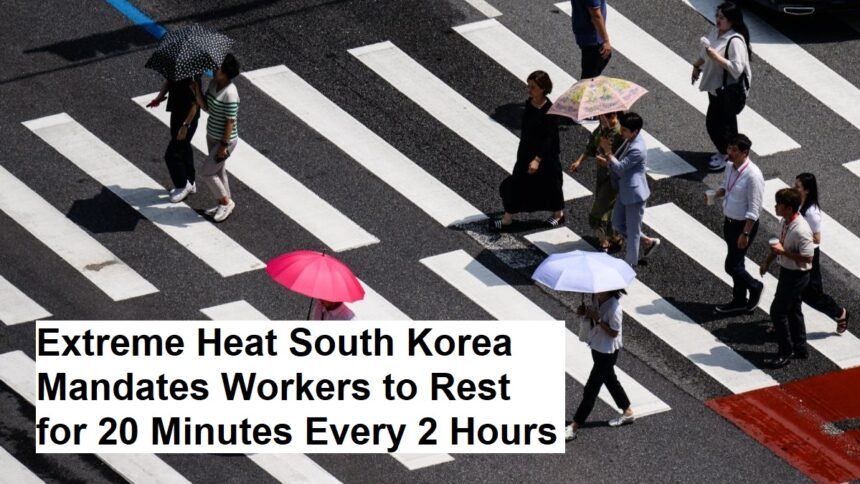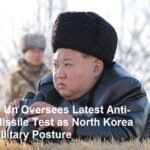Introduction
As temperatures soar across South Korea due to ongoing heatwaves, authorities have introduced new regulations aimed at protecting workers from heat-related illnesses. The government announced that all outdoor and indoor workplaces must ensure employees take a 20-minute break every two hours during periods of extreme heat, a move designed to safeguard health and improve productivity amid increasingly high temperatures.
The Rising Threat of Heatwaves in South Korea
South Korea has experienced a series of intense heatwaves over the past few summers, with recent reports indicating record-breaking temperatures. In 2023, temperatures frequently exceeded 35°C (95°F), with some days reaching closer to 40°C (104°F). The rising heat has led to a surge in heat-related health issues, including heatstroke, dehydration, and exhaustion, especially among outdoor workers such as construction crews, farmers, and warehouse staff.
Experts warn that climate change is responsible for the increasing frequency and severity of heatwaves, making it vital for governments and organizations to implement protective measures to ensure worker safety.
The New Regulations
In response to these concerns, the South Korean Ministry of Employment and Labor issued new guidelines in July 2025. These regulations stipulate that workers must take a 20-minute break every two hours during days when the heat index exceeds a certain threshold—currently set at 30°C (86°F). The measures are applicable to all workplaces, whether indoors or outdoors, where workers might be exposed to high temperatures.
Key provisions of the regulation include:
- Mandatory 20-minute rest periods every two hours during extreme heat conditions.
- Additional hydration breaks, with access to cool drinking water provided free of charge.
- Provision of shaded or cooled rest areas for outdoor workers.
- Flexible working hours or adjusted schedules to minimize heat exposure during peak daytime hours.
- Mandatory acclimatization training for new employees to help them adapt gradually to heat conditions.
Implementation Challenges and Compliance
Implementing these regulations requires concerted efforts from employers, safety inspectors, and workers. Businesses are expected to adjust their schedules, especially in physically demanding outdoor jobs. Some industries worry about potential productivity losses, but health experts emphasize that the long-term benefits—reducing heat-related illnesses and absenteeism—far outweigh short-term productivity concerns.
The government has announced plans to conduct regular inspections to ensure compliance and to penalize violations. Employers who fail to adhere to the guidelines could face fines or other penalties, including suspension of operations in severe cases.
Impact on Workers’ Safety and Well-Being
The primary goal of these measures is to protect workers from dangerous heat exposure, which can result in serious health emergencies. Heatstroke, which occurs when the body’s temperature regulation fails, can be fatal if not treated promptly. By enforcing regular breaks, workers can cool down, hydrate, and reduce the risk of heat-related health problems.
Trade unions and workers’ advocacy groups have welcomed the new regulations, emphasizing the importance of worker safety. They argue that companies often overlook heat risks, especially in small or less regulated sectors, making government oversight crucial.
Broader Context and Global Trends
South Korea’s initiative aligns with global efforts to address the health impacts of climate change. Many countries are adopting similar policies as heatwaves become more frequent worldwide. For example, parts of Europe and Australia have already implemented mandatory breaks and heat action plans during extreme heat periods.
In South Korea, climate experts predict that heatwaves will become more severe in the coming decades, prompting the government to consider additional measures such as public awareness campaigns, urban cooling projects, and investments in heat-resistant infrastructure.
Future Outlook
The new regulation reflects South Korea’s commitment to worker safety in the face of climate change. As heatwaves continue to present health and economic challenges, such policies are likely to become standard practice in many sectors.
Employers, workers, and policymakers will need to collaborate to ensure that these measures are effective and sustainable. Education and awareness campaigns will be vital to communicate the importance of taking breaks and protecting health during hot weather.
Conclusion
South Korea’s decision to mandate 20-minute breaks every two hours during extreme heat is a significant step toward safeguarding worker health amid rising temperatures. It underscores the urgent need for proactive measures in adapting to climate change’s impacts and reinforces the importance of prioritizing safety in workplaces affected by extreme weather conditions.
This policy may serve as a model for other countries facing similar challenges, emphasizing that protecting workers from heat stress is not only a health issue but also a crucial aspect of sustainable economic development in a warming world.












